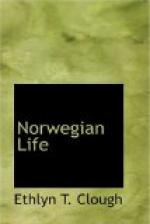The stops at the stations seem unnecessarily long to impatient Americans, but the time is utilized by the leisurely passengers in drinking big goblets of beer, and by the conductor in parading up and down the platform so that the patrons of the road can have an opportunity to admire his radiant uniform and fine shape. In Scandinavian countries the best-looking men seem to have been selected for railway conductors and policemen, and their deportment is decidedly different from what we are used to in America. If you ask a question of a Norwegian policeman, he will bring his heels together, give a military salute, and stand in the attitude of attention like a soldier while he answers. He usually understands English, too, and those who can not are remarkably accurate guessers, and all take a friendly interest in your inquiries instead of giving you a short answer and a cold shoulder like the policemen in our cities. They will walk to the corner to point out the house in the middle of the next block if that is where you want to go, and when you thank them for their attention, you get another salute that makes you feel as big as a major general, or as if you had been mistaken for a member of the royal family. Railway conductors are equally polite, and seem to understand that it is a part of their business to protect tender-footed travelers, as angels always look after good little boys.
In southern Sweden there is scarcely a parish without a railway, and in the northern part of the kingdom, where the railway facilities are limited, posting stations are maintained by the government similar to those in Norway. There is a railway running as far north as the 67th parallel of latitude, about fifty miles beyond the polar circle into Lapland, to the famous mines of Malmberget, with a branch to Trondhjem, Norway. The line follows the coast of the Gulf of Bothnia very closely, through a country well covered with small pine timber, which was being rapidly stripped until the government interfered by passing rigid regulations and appointing foresters to enforce them.
You can see the midnight sun from several places on this railway, anywhere above 66 degrees and 33 minutes of latitude, from the 9th of June to the 3d of July, and farther north for a longer period. At Gellivare the midnight sun can be seen regularly from June 5 to July 11, and it is a much more convenient and quicker journey than to the North Cape and other polar resorts in Norway. During that period a traveler is reasonably certain of seeing the sun at all hours of the day as long as he cares to stay, while over in Norway that privilege is rare and uncertain, owing to the fogs and clouds that obscure the horizon sometimes for days at a time. But there is nothing else to call the tourist to this part of Sweden, for the scenery is monotonous and uninteresting and the facilities for travel are primitive and the tourists are few.




